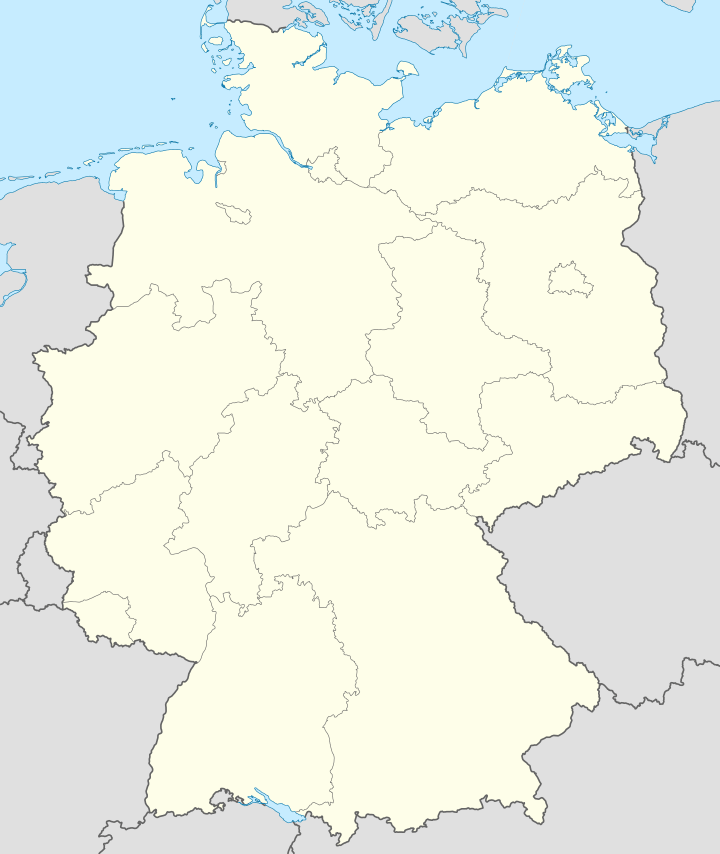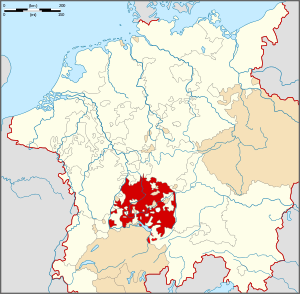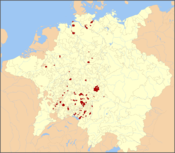Donauwörth
| Donauwörth | ||
|---|---|---|
|
Reichsstrasse, Donauwörth | ||
| ||
 Donauwörth | ||
Location of Donauwörth within Donau-Ries district  | ||
| Coordinates: 48°42′N 10°48′E / 48.700°N 10.800°ECoordinates: 48°42′N 10°48′E / 48.700°N 10.800°E | ||
| Country | Germany | |
| State | Bavaria | |
| Admin. region | Schwaben | |
| District | Donau-Ries | |
| Government | ||
| • Lord Mayor | Armin Neudert (CSU) | |
| Area | ||
| • Total | 77.02 km2 (29.74 sq mi) | |
| Population (2013-12-31)[1] | ||
| • Total | 18,550 | |
| • Density | 240/km2 (620/sq mi) | |
| Time zone | CET/CEST (UTC+1/+2) | |
| Postal codes | 86609 | |
| Dialling codes | 0906 | |
| Vehicle registration | DON | |
| Website | www.donauwoerth.de | |
Donauwörth is a city in the German State of Bavaria (Bayern), in the region of Swabia (Schwaben). It is said to have been founded by two fishermen where the Danube (Donau) and Wörnitz rivers meet. The city is part of the scenic route called "Romantische Straße" (Romantic Road)
The city is situated between Munich and Nuremberg, 46 km north of Augsburg.
History
It is historically important to Germany as the site of one of the incidents which led to the Thirty Years' War (1618–1648). In 1606, the Lutheran majority barred the Catholic residents of the town from holding an annual Markus procession, causing a riot to break out.
Donauwörth was later the scene of the Battle of Schellenberg (or Battle of Donauwörth) on 2 July 1704, during the War of the Spanish Succession (1702–1713). The battle was named after the village and high ground behind the city. The Duke of Marlborough was marching from Flanders to Bavaria and came to the Danube river. The French decided to make a crossing of the Danube at Donauwörth, where they were surprised by Marlborough's troops and after heavy fighting pulled back. This allowed Marlborough to capture Donauwörth and cross the Danube without any problem. About 5,000 French troops drowned while trying to escape.
Notable citizens
- 1291 Margareta Ebner, German mystic
- 1499 Sebastian Franck, was a 16th-century German freethinker, humanist, and radical reformer
- 1838 Franz Hartmann
- 1861 Ferdinand Bonn, stage and film actor
- 1901 Werner Egk, Composer
- 1942 Werner Schnitzer, actor
- 1948 Manfred G. Schmidt
- 1980 Carolin Hingst
- 1980 Sercan Güvenışık
Twin towns — sister cities
Donauwörth is twinned with:
See also
References
- ↑ "Fortschreibung des Bevölkerungsstandes". Bayerisches Landesamt für Statistik und Datenverarbeitung (in German). 31 December 2013.
External links
-
 Media related to Donauwörth at Wikimedia Commons
Media related to Donauwörth at Wikimedia Commons - Official website
-
 "Donauwörth". Encyclopædia Britannica (11th ed.). 1911.
"Donauwörth". Encyclopædia Britannica (11th ed.). 1911.
| ||||||||||||||||
| |||||||||||||||||||||||||||||
| ||||||||



